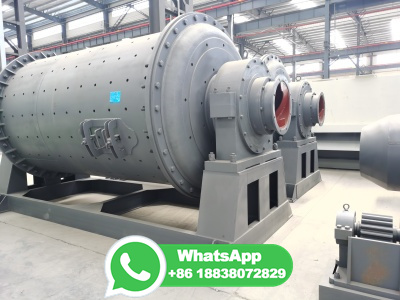
In the autumn of 1913 Bergius filed the first patent on the highpressurehydrogenation of Bergius carried out the research on coal hydrogenation,like that on heavy oil hydrogenation, in steel autoclaves, rotating and stationary, though these auto claves were of much larger capacity400 liters.
WhatsApp: +86 18203695377
In the early 20th century, German researcher Friedrich Bergius developed a process to directly liquefy coal under high temperature and pressure (coal begins to dissolve above 250 degrees centigrade), and then "crack" the coal molecules into smaller molecules using hydrogen. 2 Bergius termed the process "coal hydrogenation,"
WhatsApp: +86 18203695377
The use of catalysts to refine the coal oil appeared then to be hopeless since coals contained sulfur, a poison for all then known hydrogenation catalysts. The third input was methanol synthesis ...
WhatsApp: +86 18203695377
It has coal reserves of million tons of coal and a market cap of million, producing of value for each ton of reserves. Now, consider Sunoco, Inc., it has no oil reserves and ...
WhatsApp: +86 18203695377
Indeed, coal hydrogenation was a neglected reaction until the first decades of the twentieth century, when chemists began to study the hydrogenation process extensively. Two factors contributed to the eventual success of the hydrogenation process: the introduction of metallic catalysts and the application of high pressure. Al
WhatsApp: +86 18203695377
The Bergius process is a method of production of liquid hydrocarbons for use as synthetic fuel by hydrogenation of highvolatile bituminous coal at high temperature and pressure. It was first developed by Friedrich Bergius in 1913. In 1931 Bergius was awarded the Nobel Prize in Chemistry for his development of highpressure chemistry. [1] Process
WhatsApp: +86 18203695377
ed into oil. The German chemist, Bergius, attempted conversion of coal into oil by a process of chemical reaction involving the addition of hydrogen under high pressure in the presence of a catalyst. II Three Stages of Technological Development Berg(iuLs patenited the hydrogenation of coal ancd other solid carbonaceous material of veg,etal ...
WhatsApp: +86 18203695377
The Bergius process is a method of production of liquid hydrocarbons for use as synthetic fuel by hydrogenation of highvolatile bituminous coal at high temperature and pressure. It was first developed by Friedrich Bergius in 1913. In 1931 Bergius was awarded the Nobel Prize in Chemistry for his development of highpressure chemistry.
WhatsApp: +86 18203695377
coal tar by Bergius in Germany in the 1920s. ... the process gas is cooled while H 2S ... Colorado School of Mines is conducting coal hydrogenation research with the following objectives and scope ...
WhatsApp: +86 18203695377
Engineering Chemistry Questions and Answers Synthetic Gasoline from NonPetroleum Sources 2. This set of Engineering Chemistry Questions Answers for Exams focuses on "Synthetic Gasoline from NonPetroleum Sources 2". 1. Which type of coal is used in Bergius process? a) Anthracite coal. b) Steam coal.
WhatsApp: +86 18203695377
The major problems he confronted and successfully solved were: (1) providing enough hydrogen gas to convert coal into synthetic petroleum, (2) working at the high pressures required for the conversion, and ( 3 ) regulating the reaction's tem perature.
WhatsApp: +86 18203695377
Now syngas is a mixture of hydrogen and carbon monoxide. Synthetic petrol is mainly obtained from a process called Bergius process. In the Bergius process, hydrogen gas and coal are heated together which produces a mixture of hydrocarbons through the process of hydrogenation. The general reaction involved in this process is,
WhatsApp: +86 18203695377
The Bergius Process is a method of production of liquid hydrocarbons for use as synthetic fuel by hydrogenation of highvolatile bituminous coal at high temperature and pressure. It was first developed by Friedrich Bergius in 1913, in 1931 Bergius was awarded the Nobel Prize in Chemistry for his development of high pressure chemistry. [1]
WhatsApp: +86 18203695377
The Bergius process for coal conversion to hydrocarbons requires temperatures above 450°C 6, pyrolysis of different polymers to pyrolysis oil is also typically carried out at similar ...
WhatsApp: +86 18203695377
One of the main methods of direct conversion of coal to liquids by hydrogenation process is the Bergius process. [1] The Bergius process was developed by Friedrich Bergius in 1913. In this process, dry coal is mixed with heavy oil recycled from the process. Catalyst is typically added to the mixture.
WhatsApp: +86 18203695377
iron catalyst for this process was poisoned by even traces of sulfur compounds. Thus it became generally believed that sulfur poisons hydrogenation cata lysts. Historic Outline of the BergiusPier Process Germany is rich in coal but has only very small petroleum resources. This made conversion of coal into petroleum products of interest.
WhatsApp: +86 18203695377
Influence of the Iron Proportion on the Efficiency of an OilSoluble NiFe Catalyst Applied in the Coliquefaction of Lignite and Heavy Residue. Industrial Engineering Chemistry Research 2019, 58 (41), .
WhatsApp: +86 18203695377
The use of nascent hydrogen from hydriodic acid a t 270°C. gave 60% of the weight of the coal as oil. The industrial development of the coalhydrogenation process started with Bergius's work on the constitution of coal, which led to the conclusion t ha t molecular hydrogen reacts with coal a t eIevated temperature and high pressure.
WhatsApp: +86 18203695377
Under high pressures and temperatures, a slurry of crushed coal and processderived oil directly reacts with hydrogen in direct liquefaction (Yan, 1986). It is based on the Bergiusprocess, in which coal is dissolved under high temperatures and pressure (Klerk, 2014).
WhatsApp: +86 18203695377
The coaltooil process also interested Standard Oil of New Jersey . As a result, the StandardIG Company was created in 1929, followed in 1931 by the International Hydrogenation Patents Company, through which patents were pooled, and which included Britain's ICI and Royal DutchShell .
WhatsApp: +86 18203695377
The use of nascent hydrogen from hydriodic acid at 270°C gave 60% of the weight of the coal as oil. A fundamental improvement is achieved by the division of the hydrogenation process into two stages—namely, (1) liquidphase hydrogenation and (2) vaporphase hydrogenation. This twostage process for the hydrogenation of tar proves useful also ...
WhatsApp: +86 18203695377
2. Historic Outline of the BergiusPier Process. 3. Primary Coal Liquefaction. 4. Refining of Coal Oils References . . . . . . 1. Introduction! I 3 12 26 37 The term "Coal Liquefraction" or "Coal Hydrogenation" in this chapter describes the addition of hydrogen to coal or lignite using catalysts at elevated
WhatsApp: +86 18203695377
The Bergius process is a method of production of liquid hydrocarbons for use as synthetic fuel by hydrogenation of highvolatile bituminous coal at high temperature and pressure. It was first developed by Friedrich Bergius in 1913. In 1931 Bergius was awarded the Nobel Prize in Chemistry for his development of high pressure chemistry.
WhatsApp: +86 18203695377